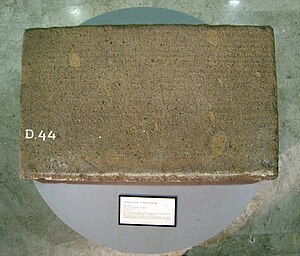
Borobudur, also transcribed Barabudur is a 9th-century Mahayana Buddhist temple in Magelang Regency, near the city of Magelang and the town of Muntilan, in Central Java, Indonesia.

Manjushri is a bodhisattva who represents prajñā of the Buddhas in Mahāyāna Buddhism. The name "Mañjuśrī" is a combination of Sanskrit word "mañju" and an honorific "śrī", it can be literally translated as "Beautiful One with Glory" or "Beautiful One with Auspiciousness". Mañjuśrī is also known by the fuller name of Mañjuśrīkumārabhūta (मञ्जुश्रीकुमारभूत), literally "Mañjuśrī, Still a Youth" or, less literally, "Prince Mañjuśrī". Another name of Mañjuśrī is Mañjughoṣa.

Prambanan is a 9th-century Hindu temple compound in the Special Region of Yogyakarta, in southern Java, Indonesia, dedicated to the Trimūrti, the expression of God as the Creator (Brahma), the Preserver (Vishnu) and the Destroyer (Shiva). The temple compound is located approximately 17 kilometres (11 mi) northeast of the city of Yogyakarta on the boundary between Central Java and Yogyakarta provinces.

Agutaya, officially the Municipality of Agutaya, is a 5th class municipality in the province of Palawan, Philippines. According to the 2020 census, it has a population of 12,867 people.

The Mataram Kingdom ; also known as Medang Kingdom was a Javanese Hindu–Buddhist kingdom that flourished between the 8th and 11th centuries. It was based in Central Java, and later in East Java. Established by King Sanjaya, the kingdom was ruled by the Shailendra dynasty and Ishana dynasty.

Kalasan, also known as Candi Kalibening, is an 8th-century Buddhist temple in Java, Indonesia. It is located 13 kilometers (8.1 mi) east of Yogyakarta on the way to Prambanan temple, on the south side of Jalan Solo main road between Yogyakarta and Surakarta. Administratively, it is located in the Kalasan District (kapanewon) of Sleman Regency.

Ratu Boko or Ratu Boko Palace is an archaeological site in Java. Ratu Boko is located on a plateau, about three kilometres south of Prambanan temple complex in Yogyakarta, Indonesia. The original name of this site is still unclear, however the local inhabitants named this site after King Boko, the legendary king mentioned in Roro Jonggrang folklore. In Javanese, Ratu Boko means "Stork King".

A candi is a Hindu or Buddhist temple in Indonesia, mostly built during the Zaman Hindu-Buddha or "Hindu-Buddhist period" between circa the 4th and 15th centuries.
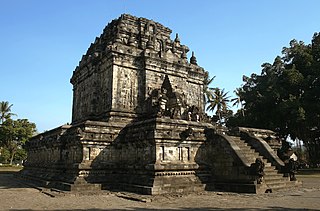
Mendut is a ninth-century Buddhist temple, located in Mendut village, Mungkid sub-district, Magelang Regency, Central Java, Indonesia. The temple is located about three kilometres east of Borobudur. Mendut, Borobudur, and Pawon, all of which are Buddhist temples, are located in one straight line. There is a mutual religious relationship between the three temples, although the exact ritual process is unknown.
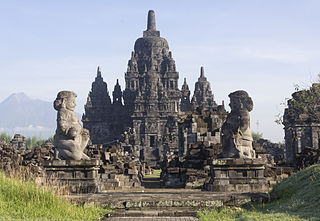
Sewu is an eighth-century Mahayana Buddhist temple located 800 metres north of Prambanan in Central Java, Indonesia. The word for a Hindu or Buddhist temple in Indonesian is "candi", hence the common name is "Candi Sewu". Candi Sewu is the second largest Buddhist temple complex in Indonesia; Borobudur is the largest. Sewu predates near the "Loro Jonggrang" temple at Prambanan. Although the complex consists of 249 temples, this Javanese name translates to 'a thousand temples,' which originated from popular local folklore. Archaeologists believe the original name for the temple compound to be Manjusrigrha.

Prambanan Temple Compounds is the World Heritage designation of a group of Hindu temple compounds that lie on the border between Yogyakarta and Central Java, Indonesia. It comprises Prambanan, Lumbung, Bubrah and Sewu temple compounds, all are located within Prambanan Archaeological Park.

Borobudur Temple Compounds is the World Heritage designation of the area of three Buddhist temples in Central Java, Indonesia. It comprises Borobudur, Mendut, and Pawon. The temples were built during the Shailendra dynasty around the 8th and 9th centuries CE and fall on a straight line.
Rakai Pikatan was a king of the Sanjaya dynasty Mataram Kingdom in Central Java who built the Prambanan temple, dedicated to Shiva, which was completed in 856 AD. Rakai Pikatan was also called Mpu Manuku.

Pramodhawardhani was the queen consort of King Rakai Pikatan of Mataram Kingdom in 9th century Central Java. She was the daughter of Sailendran king Samaratungga.
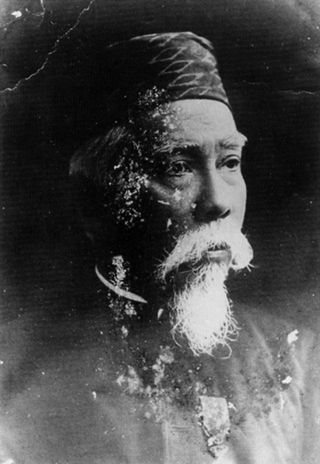
Kassian Cephas or Kassian Céphas was a Javanese photographer of the court of the Yogyakarta Sultanate. He was the first indigenous person from Indonesia to become a professional photographer and was trained at the request of Sultan Hamengkubuwana VI. After becoming a court photographer in as early 1871, he began working on portrait photography for members of the royal family, as well as documentary work for the Dutch Archaeological Union. Cephas was recognized for his contributions to preserving Java's cultural heritage through membership in the Royal Netherlands Institute of Southeast Asian and Caribbean Studies and an honorary gold medal of the Order of Orange-Nassau. Cephas and his wife Dina Rakijah raised four children. Their eldest son Sem Cephas continued the family's photography business until his own death in 1918.

Kewu Plain, also known as Prambanan Plain or Opak River Valley, is a fertile volcanic plain that lies between the Merapi-Merbabu complex in the north, the Bantul lowlands and Sewu karst limestone range in the south, Bengawan Solo river valley in the east, the Progo River in the west, and Kedu Plain on the northwest. It is located within the Yogyakarta Special Region, Sleman Regency, Klaten Regency, and Solo City, Indonesia.

Sojiwan is a 9th-century Mahayana Buddhist temple located in Kebon Dalem Kidul village, Prambanan, Klaten Regency, Central Java. The temple is located nearly two kilometres southeast of Prambanan temple. This temple is among number of temples scattered in Prambanan Plain.
Karangtengah inscription is the inscription written on five pieces of stones dated 746 Saka or 824 CE, discovered in Karangtengah hamlet, Temanggung Regency, Central Java, Indonesia. The inscription was written in ancient Javanese script in two languages; Old Javanese and Sanskrit. Lines 1-24 were written in Sanskrit, and the rest of the lines were written in old Javanese. The inscription is linked with the temples Borobudur and Mendut.

The Manjusrigrha inscription is an inscription dated 714 Saka, written in Old Malay with Old Javanese script. The inscription was discovered in 1960 on the right side of the stairs entrance of Sewu pervara no. 202 on the west side. This inscription is linked to the Sewu temple. According to this inscription, the original name of the Sewu temple compound is probably Manjusrigrha. Sewu temple is located approximately 800 meters north of Prambanan temple, Central Java, Indonesia. The inscription was carved on an andesite stone block measured 71 cm x 42 cm x 29 cm.
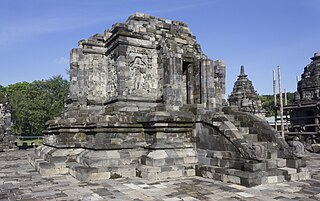
Lumbung or Candi Lumbung is a 9th-century Buddhist temple compound located within the complex of Prambanan Temple Tourism Park, Central Java, Indonesia. The original name of this temple is unknown, however the local Javanese named the temple "candi lumbung", which means "rice barn temple" in Javanese language.
